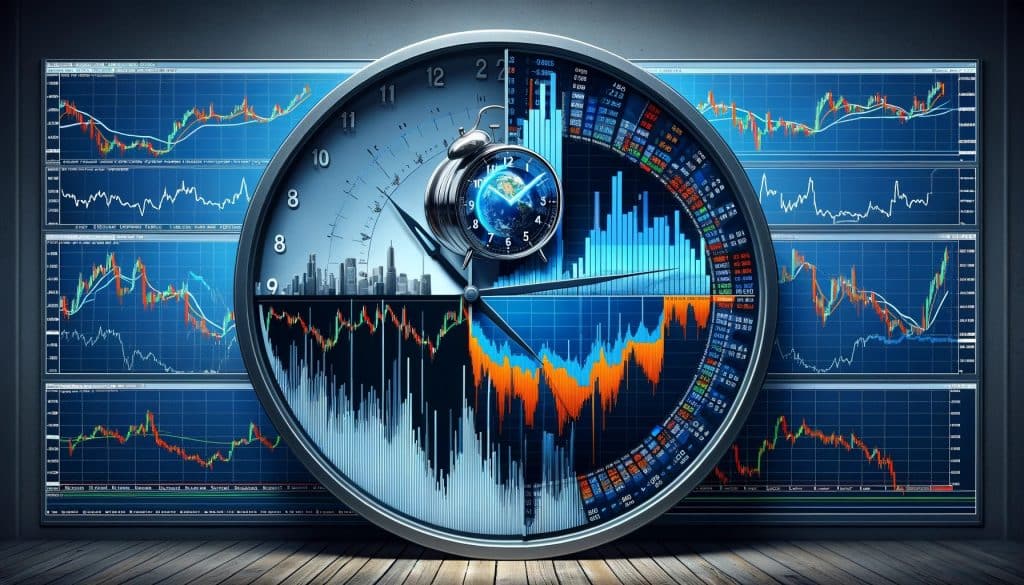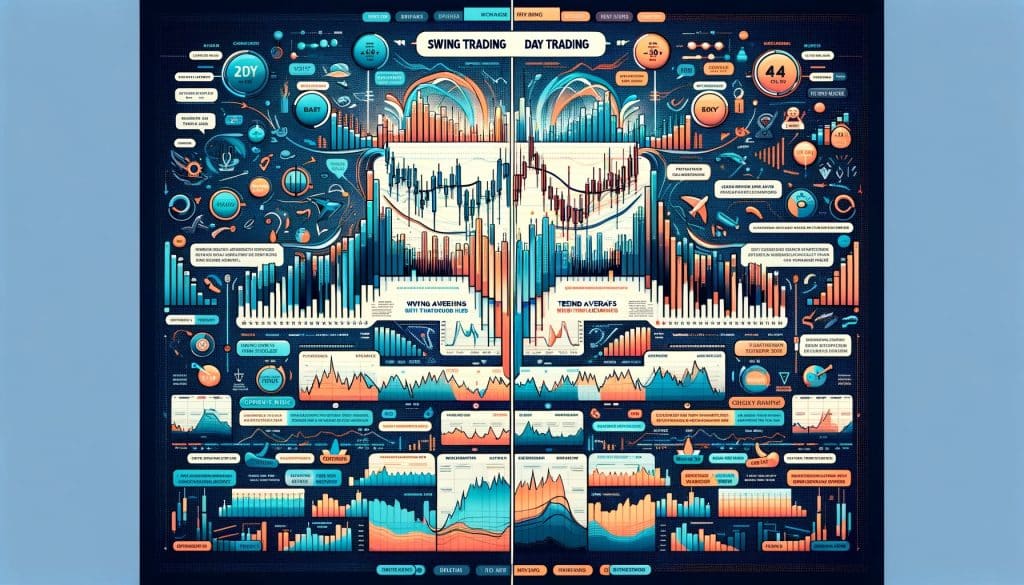In the dynamic world of Forex trading, choosing the right strategy is crucial for achieving financial success and sustainability. Among the plethora of strategies available, swing trading and day trading stand out as popular choices for both novice and experienced traders. This comprehensive guide delves into the nuances of swing trading vs day trading, aiming to equip you with the knowledge to decide which strategy best suits your trading style, risk tolerance, and lifestyle.
Understanding Swing Trading and Day Trading
Before comparing swing trading vs day trading, it’s essential to define and understand what each strategy entails.
What is Swing Trading?
Swing trading is a medium-term strategy that involves holding positions for several days to weeks to capitalize on expected directional moves or ‘swings’ in the Forex market. Swing traders utilize technical analysis, fundamental analysis, and market sentiment to make their trading decisions, aiming to profit from price movements within a broader trend.
What is Day Trading?
Day trading is a short-term strategy where traders buy and sell currency pairs within the same trading day. The goal is to capitalize on small price movements within the market’s open hours. Day traders rely heavily on technical analysis and real-time news to make quick decisions, often executing many trades in a day to accumulate profits from minor price changes.

Swing Trading vs. Day Trading: Key Differences
Trading Timeframe and Commitment
- Swing trading allows for a more flexible trading schedule, as positions are held over days or weeks, requiring less constant market monitoring.
- Day trading demands a high level of commitment and attention, as traders need to monitor the markets and make quick decisions throughout the trading day.
Risk and Reward Potential
- Swing trading involves potentially higher risk and reward due to holding positions overnight or longer, exposing trades to overnight market changes.
- Day trading limits exposure to overnight risks but also caps the potential rewards, as trades are limited to the price movements within a single day.
Capital Requirements
- Swing trading typically requires less capital than day trading because it does not demand the same level of margin and allows for fewer, but larger, trades.
- Day trading in the Forex market often requires a significant amount of capital to effectively capitalize on small price movements and cover the higher transaction costs from frequent trading.

Choosing the Right Strategy for You
Personality and Lifestyle
Your trading strategy should align with your personality and lifestyle. If you prefer a fast-paced environment and can dedicate the entire trading day to monitoring the markets, day trading might suit you. Conversely, if you prefer analyzing the market on a broader scale and cannot commit full days to trading, swing trading could be a better fit.
Risk Tolerance
Consider your risk tolerance. Swing trading exposes you to overnight and weekend market risks, which can result in significant price gaps. If you’re comfortable with this level of risk for the potential of higher rewards, swing trading may be appealing. Day trading, while potentially less risky in terms of market gaps, requires quick decision-making under pressure, which also carries its own set of risks.
Financial Goals
Your financial goals play a crucial role in determining the right strategy. If your goal is to generate steady income and you have the capital to trade at higher volumes, day trading might be more appropriate. For those looking to build wealth over time with fewer transactions and possibly less capital, swing trading could be more advantageous.

Combining Swing Trading and Day Trading
While most traders lean towards one strategy, combining elements of both swing trading and day trading can offer a balanced approach. For instance, you could use swing trading for the bulk of your portfolio to capture larger market movements while allocating a smaller portion for day trading to capitalize on short-term opportunities. This hybrid approach allows traders to diversify their strategies and mitigate risks.
FAQs about Swing Trading vs. Day Trading
What are the main differences between swing trading and day trading?
The primary difference lies in the holding period of trades and the time commitment required. Swing traders hold positions for several days to weeks, capitalizing on medium-term market trends. Day traders, on the other hand, buy and sell within the same trading day to profit from short-term price movements, requiring constant market monitoring.
Which strategy requires more initial capital, swing trading or day trading?
Day trading generally requires more initial capital due to the high frequency of trades and the need to capture small price movements, which often involves leveraging larger positions. Swing trading can be started with less capital as it focuses on fewer, potentially larger moves over a longer period.
Is swing trading or day trading better for beginners?
Swing trading is often considered more suitable for beginners due to its slower pace and the reduced need for constant market monitoring. It allows beginners to take their time analyzing and making decisions, which can be less stressful and more educational.
How important is technical analysis in swing trading and day trading?
Technical analysis is crucial for both strategies but used differently. Day traders rely on technical analysis to make quick decisions based on short-term price movements. Swing traders also use technical analysis to identify potential entry and exit points, but they may also incorporate fundamental analysis to strengthen their strategy over a longer term.
Can I do both swing trading and day trading?
Yes, many traders use a combination of both strategies to diversify their trading activities and capitalize on different market opportunities. However, managing both simultaneously requires a good understanding of each strategy’s demands, significant time commitment, and the ability to switch between different trading mindsets.
Which strategy is more profitable, swing trading or day trading?
Profitability can vary widely among individuals and depends on factors such as market conditions, the trader’s skill level, and risk management practices. Both strategies have the potential to be profitable, but they also carry risks. The key to success is finding a strategy that fits your trading style, risk tolerance, and financial goals.
How does market volatility affect swing trading and day trading?
Market volatility can have different impacts on swing trading and day trading. Day traders may benefit from increased volatility, as it can create more short-term trading opportunities. Swing traders might find high volatility challenging as it can lead to significant price gaps that may adversely affect open positions held overnight.
What risk management techniques are essential for swing trading and day trading?
For both strategies, setting stop-loss orders, managing position sizes, and not risking more than a certain percentage of the trading capital on a single trade are fundamental risk management techniques. Additionally, day traders may use daily loss limits to protect against significant losses in a single day.
Do swing traders or day traders need to monitor the markets more closely?
Day traders need to monitor the markets more closely than swing traders due to the short-term nature of their trades. Day trading involves making quick decisions based on minute-to-minute price movements, requiring constant vigilance during trading hours. Swing traders, while still needing to keep an eye on the markets, generally make decisions based on longer-term trends and may not need to watch the markets as closely throughout the day.

Conclusion: Tailoring the Strategy to Fit Your Trading Profile
In the debate of swing trading vs day trading, there is no one-size-fits-all answer. The best strategy depends on your individual preferences, lifestyle, risk tolerance, and financial objectives. By understanding the fundamental differences and evaluating how each aligns with your personal trading profile, you can make an informed decision on which strategy to pursue.
Embrace the journey of Forex trading with a strategy that resonates with your goals and lifestyle. Whether you choose swing trading, day trading, or a combination of both, the key to success lies in consistent learning, practice, and adaptation to the ever-changing Forex market.





